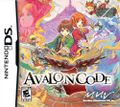Unununium10 (talk | contribs) (Brand new game-- Unununium10 (;) |
m (Update guide main page) |
||
| (6 intermediate revisions by 5 users not shown) | |||
| Line 1: | Line 1: | ||
{{Header Nav|game=Avalon Code}} | |||
{{Game | |||
|completion=1 | |||
{{Header Nav|game= | |image=AvalonCode jpcover.jpg | ||
|title=Avalon Code | |||
|title= | |japanese=アヴァロンコード | ||
| | |developer=[[Matrix Software]] | ||
|developer=Matrix Software | |publisher={{colist|Marvelous Entertainment|Rising Star Games}} | ||
|publisher= Marvelous Entertainment | |year=2008 | ||
| | |systems={{syslist|ds}} | ||
|ratings={{CERO|A}}{{ESRB|E10}}{{PEGI|12}} | |||
|genre=[[Action RPG]] | |||
|modes=[[Single player]] | |||
|genre=Action role-playing game | }} | ||
{{nihongo|'''Avalon Code'''|アヴァロンコード|''Avaron Kodo''}} is an [[action]] [[role-playing game]] developed by [[Matrix Software]] for the [[Nintendo DS]] released in Japan on November 1, [[2008]], in North America on March 10, [[2009]] and in Europe on March 12, [[2010]]. | |||
| | <gallery> | ||
File:AvalonCode nacover.jpg|North American cover art. | |||
</gallery> | |||
==Story== | |||
The main character (a boy whose default name is Yumil, or a girl whose default name is Tia) has been having nightmares about the end of the world. They are told that they have been chosen by the powers-that-be - but not to save the world. Their job is to use a magic tome called the Book of Prophecy to record what is worth saving, so that that information may be used to create the next world. | The main character (a boy whose default name is Yumil, or a girl whose default name is Tia) has been having nightmares about the end of the world. They are told that they have been chosen by the powers-that-be - but not to save the world. Their job is to use a magic tome called the Book of Prophecy to record what is worth saving, so that that information may be used to create the next world. | ||
The protagonist finds and befriends four helpful Spirits taking residence inside the Book. Throughout the journey, they learn about a plot to hasten the end of the world, as well as what happened to the Book's last Chosen One. | The protagonist finds and befriends four helpful Spirits taking residence inside the Book. Throughout the journey, they learn about a plot to hasten the end of the world, as well as what happened to the Book's last Chosen One. | ||
{{ToC}} | |||
[[Category:Matrix Software]] | |||
[[Category:Action RPG]] | |||
[[Category:Single player]] | |||
Latest revision as of 01:51, 2 April 2023

| Avalon Code | |
|---|---|
| Developer(s) | Matrix Software |
| Publisher(s) | Marvelous Entertainment, Rising Star Games |
| Year released | 2008 |
| System(s) | Nintendo DS |
| Japanese title | アヴァロンコード |
|---|---|
| Genre(s) | Action RPG |
| Modes | Single player |
| Rating(s) |
Avalon Code (アヴァロンコード Avaron Kodo?) is an action role-playing game developed by Matrix Software for the Nintendo DS released in Japan on November 1, 2008, in North America on March 10, 2009 and in Europe on March 12, 2010.
-
North American cover art.
Story[edit]
The main character (a boy whose default name is Yumil, or a girl whose default name is Tia) has been having nightmares about the end of the world. They are told that they have been chosen by the powers-that-be - but not to save the world. Their job is to use a magic tome called the Book of Prophecy to record what is worth saving, so that that information may be used to create the next world.
The protagonist finds and befriends four helpful Spirits taking residence inside the Book. Throughout the journey, they learn about a plot to hasten the end of the world, as well as what happened to the Book's last Chosen One.
